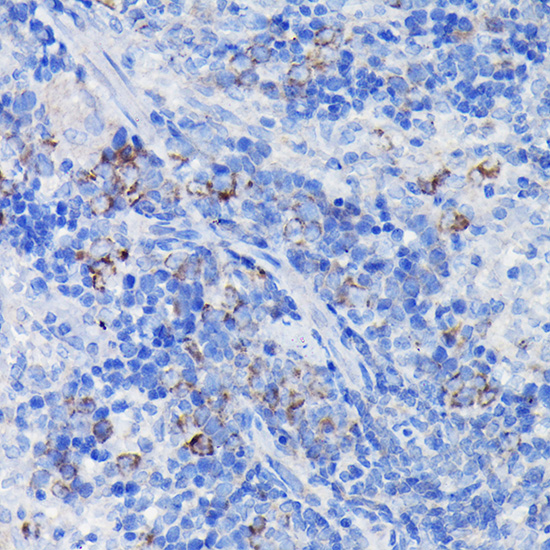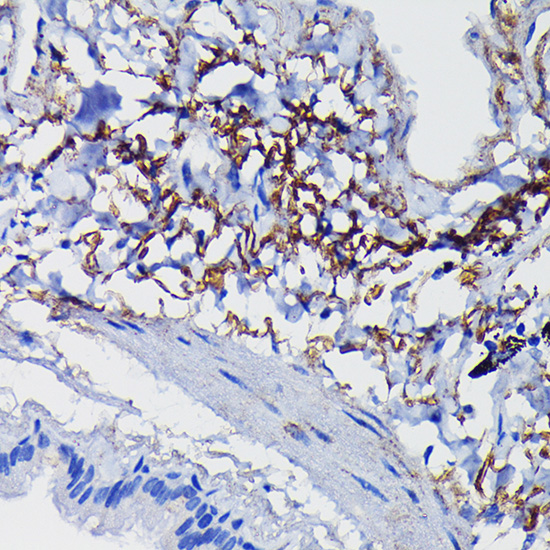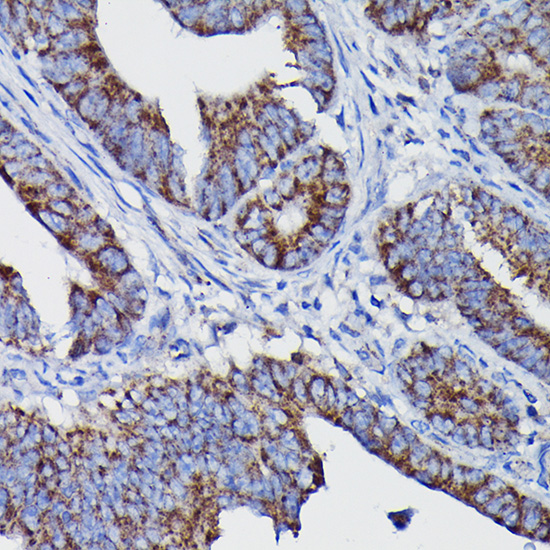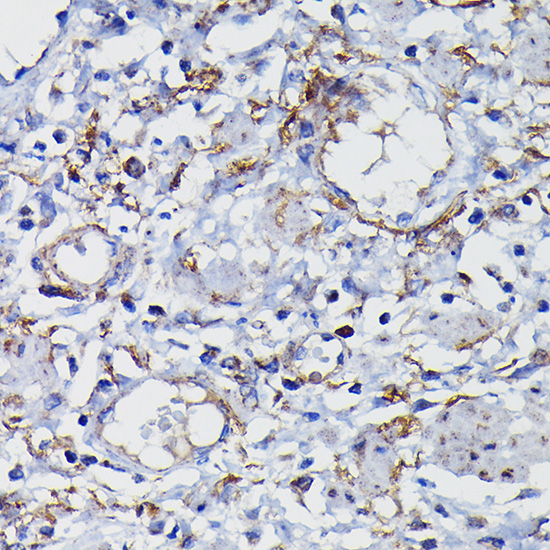Anti-CLU Antibody (CAB12913)
- SKU:
- CAB12913
- Product type:
- Antibody
- Reactivity:
- Human
- Mouse
- Rat
- Host Species:
- Rabbit
- Isotype:
- IgG
- Antibody Type:
- Polyclonal Antibody
- Research Area:
- Cell Death
Description
| Antibody Name: | Anti-CLU Antibody |
| Antibody SKU: | CAB12913 |
| Antibody Size: | 20uL, 50uL, 100uL |
| Application: | WB IHC |
| Reactivity: | Human, Mouse, Rat |
| Host Species: | Rabbit |
| Immunogen: | Recombinant fusion protein containing a sequence corresponding to amino acids 23-120 of human CLU (NP_001822.3). |
| Application: | WB IHC |
| Recommended Dilution: | WB 1:500 - 1:2000 IHC 1:50 - 1:200 |
| Reactivity: | Human, Mouse, Rat |
| Positive Samples: | Human plasma, Mouse plasma, Rat plasma |
| Immunogen: | Recombinant fusion protein containing a sequence corresponding to amino acids 23-120 of human CLU (NP_001822.3). |
| Purification Method: | Affinity purification |
| Storage Buffer: | Store at -20°C. Avoid freeze / thaw cycles. Buffer: PBS with 0.02% sodium azide, 50% glycerol, pH7.3. |
| Isotype: | IgG |
| Sequence: | DQTV SDNE LQEM SNQG SKYV NKEI QNAV NGVK QIKT LIEK TNEE RKTL LSNL EEAK KKKE DALN ETRE SETK LKEL PGVC NETM MALW EECK PCLK QT |
| Gene ID: | 1191 |
| Uniprot: | P10909 |
| Cellular Location: | Cytoplasm, Cytoplasmic side, Cytoplasmic vesicle, Endoplasmic reticulum, Microsome, Mitochondrion membrane, Nucleus, Peripheral membrane protein, Secreted, chromaffin granule, cytosol, secretory vesicle |
| Calculated MW: | 32kDa/48kDa/52kDa/53kDa/57kDa |
| Observed MW: | 37-40KDa |
| Synonyms: | CLU, AAG4, APO-J, APOJ, CLI, CLU1, CLU2, KUB1, NA1/NA2, SGP-2, SGP2, SP-40, TRPM-2, TRPM2, clusterin |
| Background: | The protein encoded by this gene is a secreted chaperone that can under some stress conditions also be found in the cell cytosol. It has been suggested to be involved in several basic biological events such as cell death, tumor progression, and neurodegenerative disorders. Alternate splicing results in both coding and non-coding variants. |
| UniProt Protein Function: | CLU: Isoform 1 functions as extracellular chaperone that prevents aggregation of nonnative proteins. Prevents stress- induced aggregation of blood plasma proteins. Inhibits formation of amyloid fibrils by APP, APOC2, B2M, CALCA, CSN3, SNCA and aggregation-prone LYZ variants (in vitro). Does not require ATP. Maintains partially unfolded proteins in a state appropriate for subsequent refolding by other chaperones, such as HSPA8/HSC70. Does not refold proteins by itself. Binding to cell surface receptors triggers internalization of the chaperone-client complex and subsequent lysosomal or proteasomal degradation. Secreted isoform 1 protects cells against apoptosis and against cytolysis by complement. Intracellular isoforms interact with ubiquitin and SCF (SKP1-CUL1-F-box protein) E3 ubiquitin-protein ligase complexes and promote the ubiquitination and subsequent proteasomal degradation of target proteins. Promotes proteasomal degradation of COMMD1 and IKBKB. Modulates NF-kappa-B transcriptional activity. Nuclear isoforms promote apoptosis. Mitochondrial isoforms suppress BAX-dependent release of cytochrome c into the cytoplasm and inhibit apoptosis. Plays a role in the regulation of cell proliferation. Belongs to the clusterin family. 5 isoforms of the human protein are produced by alternative splicing. |
| UniProt Protein Details: | Protein type:Secreted; Apoptosis; Mitochondrial; Secreted, signal peptide Chromosomal Location of Human Ortholog: 8p21-p12 Cellular Component: extracellular matrix; Golgi apparatus; extracellular space; mitochondrion; endoplasmic reticulum; perinuclear region of cytoplasm; mitochondrial membrane; cytoplasm; extracellular region; nucleus; cytosol Molecular Function:protein binding; chaperone binding; ubiquitin protein ligase binding; ATPase activity; misfolded protein binding Biological Process: platelet activation; release of cytochrome c from mitochondria; response to misfolded protein; positive regulation of nitric oxide biosynthetic process; protein stabilization; positive regulation of apoptosis; response to virus; cell morphogenesis; microglial cell activation; positive regulation of tumor necrosis factor production; negative regulation of protein homooligomerization; activation of NF-kappaB transcription factor; complement activation; reverse cholesterol transport; platelet degranulation; myelin maintenance in the central nervous system; positive regulation of proteasomal ubiquitin-dependent protein catabolic process; protein import; innate immune response; lipid metabolic process; blood coagulation; chaperone-mediated protein complex assembly; complement activation, classical pathway |
| NCBI Summary: | The protein encoded by this gene is a secreted chaperone that can under some stress conditions also be found in the cell cytosol. It has been suggested to be involved in several basic biological events such as cell death, tumor progression, and neurodegenerative disorders. Alternate splicing results in both coding and non-coding variants.[provided by RefSeq, May 2011] |
| UniProt Code: | P10909 |
| NCBI GenInfo Identifier: | 116533 |
| NCBI Gene ID: | 1191 |
| NCBI Accession: | P10909.1 |
| UniProt Secondary Accession: | P10909,P11380, P11381, Q2TU75, Q5HYC1, Q7Z5B9, B2R9Q1 B3KSE6, |
| UniProt Related Accession: | P10909,AAB25217 |
| Molecular Weight: | Calculated: 32kDa/48kDa/52kDa/53kDa/57kDaObserved: 40kDa |
| NCBI Full Name: | Clusterin |
| NCBI Synonym Full Names: | clusterin |
| NCBI Official Symbol: | CLU |
| NCBI Official Synonym Symbols: | CLI; AAG4; APOJ; CLU1; CLU2; KUB1; SGP2; APO-J; SGP-2; SP-40; TRPM2; TRPM-2; NA1/NA2 |
| NCBI Protein Information: | clusterin; apolipoprotein J; ku70-binding protein 1; sulfated glycoprotein 2; aging-associated protein 4; complement lysis inhibitor; complement cytolysis inhibitor; complement-associated protein SP-40,40; testosterone-repressed prostate message 2 |
| UniProt Protein Name: | Clusterin |
| UniProt Synonym Protein Names: | Aging-associated gene 4 protein; Apolipoprotein J; Apo-J; Complement cytolysis inhibitor; CLI; Complement-associated protein SP-40,40; Ku70-binding protein 1; NA1/NA2; Testosterone-repressed prostate message 2; TRPM-2 |
| Protein Family: | Clusterin |
| UniProt Gene Name: | CLU |
| UniProt Entry Name: | CLUS_HUMAN |










